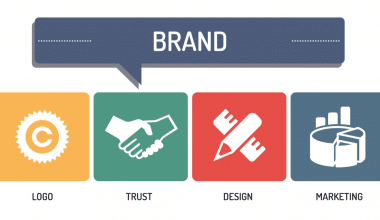Have you ever walked into a shop or restaurant and felt like you were in a special place? Maybe it’s the colors, the music, or the way the staff treats you. That’s not an accident. It’s because the owners of that shop or restaurant have carefully created an image and feeling that they want you to experience. This is what we call ‘brand identity’. But how do they do it? And what’s the difference between ‘branding’ and ‘brand identity’? In this article, we’ll explore the importance of branding vs brand identity and how each one contributes to a business’s success.
Key Points
- Branding is the strategic process of shaping perceptions and building relationships with your audience by defining your brand’s purpose, values, and identity.
- Brand identity is the visual and verbal representation of your brand, including elements like logos, colors, and typography, which creates a recognizable image for your audience.
- Branding involves ongoing actions like content creation and social media engagement to communicate your business’s values, while brand identity consists of tangible materials that visually represent those values.
- A strong brand identity helps differentiate your business from competitors, creating a memorable and cohesive image that builds customer loyalty and trust.
- Consistent branding across all touchpoints, supported by a well-defined brand identity, enhances recognition, drives growth, and establishes a lasting impact on your audience.
What Is Branding?
Branding is the process of creating a relationship with your audience by shaping perceptions and building awareness. It defines your brand’s purpose, value, and identity. Branding is a business-wide process that manages internal and external perceptions, creating value in consumers’ hearts and minds. Branding involves developing content, building a social media following, and designing business collateral to shape perceptions.
A high-level strategy guides branding decisions, ensuring authenticity and clarity. Branding is the deliberate process of strategically shaping your brand and expressing its personality and purpose. It’s an ongoing process that occurs through every website launch, social media post, email campaign, and client communication, marrying brand strategy and identity for clarity and consistency.
What Is Brand Identity?
Your brand’s visual identity is its visual expression, comprising elements like logos, color schemes, and typography that set you apart from competitors. A strong brand identity is crucial for business growth, building a foundation for positioning, messaging, strategy, and design. Every visual and verbal element should be well-planned and intentional, including logos, colors, typography, tone of voice, and messaging strategy, to differentiate you from competitors at every touchpoint. Brand identity is the tangible representation of your brand, encompassing visual and verbal elements that manifest its essence. Design is the foundation of brand identity, comprising visual elements like logos, color palettes, typography, and tone of voice, which, paired with branding, create a brand image.
Differences Between Branding vs Brand Identity
Branding is the process of creating a relationship with your audience, while a brand is a name, symbol, or feature that distinguishes a seller’s good or service from others. Branding is an action that communicates your business’s purpose and values, such as sending out an email campaign, posting on social media, and creating new website content.
A brand identity, on the other hand, is the tangible representation of your brand, including visual features like color, design, and logo. It’s the material form of your brand, such as stationery, brochures, and signage, that your audience associates with your brand.
For instance, branding is when you create a career coaching business and want to be perceived as professional and exclusive. You would use a specific tone of voice, visual elements, and messaging to communicate that. Branding is the action of forming your company’s image, while brand identity is the tangible elements that make up that image.
The Importance of Brand Identity in Your Business
Brand identity is the visual representation of a brand’s values and personality, setting the tone for how customers perceive and interact with the brand. It encompasses various elements such as logos, color schemes, typography, and imagery, all working together to create a cohesive and recognizable brand image.
A well-designed brand identity communicates a brand’s message and promotes its goals, helping to establish a strong foundation for the business.
Consistency is key to building a strong brand identity. Using the same visual elements and design style across all marketing materials creates a cohesive branding package that reinforces the brand’s message and values. This consistency helps customers recognize and remember the brand, building trust and loyalty over time. By using the same font, color scheme, and imagery across all materials, businesses can create a recognizable brand that stands out in a crowded market.
Here is a FREE Consistency Monitoring Checklist to help you more:
Consistency Monitoring Checklist.PDF
A strong brand identity also differentiates a business from its competitors, setting it apart and making it more memorable to customers. By developing a unique and professional brand identity, businesses can establish themselves as leaders in their industry, building a loyal customer base and driving growth. This differentiation is crucial in today’s competitive market, where customers have many options to choose from.
In addition to consistency and differentiation, a strong brand identity also builds customer loyalty and trust. When customers connect with a brand on an emotional level, they are more likely to return to that brand and recommend it to others. This loyalty is built through consistent branding, quality products or services, and positive customer experiences. By investing in a strong brand identity, businesses can establish a loyal customer base that drives growth and success.
Finally, a strong brand identity increases awareness about a business’s products or services, exposing the brand to new customers and driving sales. By featuring the brand prominently in marketing materials, businesses can increase visibility and reach a wider audience. This increased awareness is crucial for businesses looking to grow and expand their customer base.
The Importance of Branding for Your Business

Branding is essential for businesses as it improves recognition, creates loyal customers, and differentiates a company from its competitors. Consistent branding across all channels makes a brand more recognizable, while a strong brand image can create positive associations with quality, value, or a particular lifestyle, influencing purchasing decisions.
Branding gives a business an identity, making it more relatable and memorable to consumers. It supports marketing and advertising efforts, boosts employee pride, and increases business value. A strongly established brand can increase a business’s value, making it a more appealing investment opportunity.
Branding generates new customers through word of mouth and creates trust within the marketplace. A positive brand reputation precedes it, making potential customers more likely. to make a purchase. Employees working for a strongly branded company are more satisfied and have a higher degree of pride in their work.
Overall, branding is crucial for businesses as it shapes consumer perceptions, creates an identity, and drives growth. It’s essential to invest in branding to establish a strong reputation, build trust, and ultimately increase business value.
How to Build Your Brand Identity
Here are the detailed explanations for each step on how to build your brand identity:
#1. Define Your Brand’s Purpose, Vision, and Values
Defining your brand’s purpose, vision, and values is the foundation for building a strong brand identity. Your brand’s purpose is the reason it exists, beyond making a profit. It’s the impact you want to make on the world. Your vision statement is a clear and concise description of what you want to achieve as a brand. Your core values are the guiding principles that shape your brand’s behavior and decision-making.
#2. Develop a Unique Value Proposition
A unique value proposition (UVP) is a statement that clearly communicates what sets your brand apart from others. It’s a unique benefit that customers can only get from your brand. To develop a UVP, identify what makes your brand different, what problems you solve for customers, and what values you offer. Your UVP should be concise, clear, and compelling.
#3. Create a Visual Brand Identity
Your visual brand identity is the collection of visual elements that represent your brand. This includes:
- Logo: A logo is a symbol or icon that represents your brand. It should be simple, memorable, and scalable.
- Color Palette: A color palette is a selection of colors that reflect your brand’s personality and values. Colors can evoke emotions and convey meaning, so choose colors that align with your brand’s tone and message.
- Typography: Typography refers to the font styles and sizes used in your branding. Choose typography that aligns with your brand’s tone and is consistent across all channels.
- Imagery: Imagery includes the types of images used in your branding, such as photography style, graphics, and illustrations. Ensure your imagery aligns with your brand’s tone and message.
#4. Establish a Tone of Voice
Your tone of voice is the language and tone used in your branding. It should reflect your brand’s personality and values. Ensure your tone is consistent across all channels, including website copy, social media, and customer service interactions.
#5. Create Consistent Messaging
Consistent messaging ensures that all marketing materials and channels communicate the same message. Develop a messaging framework that aligns with your brand’s purpose, vision, and values. Ensure all messaging is clear, concise, and compelling.
#6. Develop a Brand Positioning Statement
A brand positioning statement is a statement that clearly communicates your brand’s unique value proposition and differentiates it from competitors. It should include:
- Target audience: Who your brand is for
- Unique value proposition: What sets your brand apart?
- Competitive landscape: How your brand fits into the market
#7. Create a Brand Guidelines Document
A brand guidelines document outlines how to use your brand’s visual identity, tone of voice, and messaging consistently across all channels. It should include:
- Logo usage guidelines
- Color palette guidelines
- Typography guidelines
- Imagery guidelines
- The tone of voice guidelines
- Messaging guidelines
#8. Launch and Monitor Your Brand Identity
Launch your brand identity across all channels, including your website, social media, and marketing materials. Monitor your brand’s performance and make adjustments as needed to ensure consistency and effectiveness.
What Is the Difference Between Brand Identity and Brand Equity?
Brand equity is the public’s perceived valuation of a brand. When the elements of your brand identity create a coherent picture of your mission and values, customers are left with a positive impression of your company.
Is the Slogan Part of the Brand Identity?
These taglines are simple and memorable and create an emotional connection with the customer. They communicate the company’s values or services and are an important part of creating a brand. Yes, brand identity and slogan are linked.
What Are the Three Components of Brand Identity?
Understanding the three components of brand identity—verbal, visual, and emotional—is the first step towards building a strong brand that resonates with your dream clients, builds loyalty, helps you stand out from the competition, and attracts new customers and clients.
Conclusion
Branding and brand identity are two distinct concepts that are crucial to creating a cohesive and successful marketing strategy. While they are similar, understanding their differences is vital. Branding refers to the process of creating an image, tone, and message that resonates with your audience. Brand identity, on the other hand, is the visual and emotional representation of your company that evokes feelings and associations in your customers.
A well-crafted branding strategy that evolves with trends like social media can help create positive experiences and emotions, making your company recognized and remembered. By understanding the dynamics of branding and brand identity, you can harness their power to weave your company into the fabric of your customers’ lives.
Related Articles
- Branding vs. Marketing: Examples and Differences
- Branding vs. Performance Marketing: Which Strategy Drives Better Results?
- Understanding the Concept of Branding vs. Marketing vs. Sales
- Branding vs. Packaging: Key Strategies for Standing Out in Nigeria’s Market






